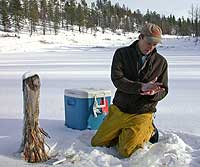Apr 3 2008
Inspired by data sent from NASA robots on Mars, Dr. Ronald Peterson, Professor of Geology at Queen’s University in Kingston, Canada, has observed a new mineral species on Earth, and predicts that it also exists on Mars. The mineral, meridianiite (MgSO4.11H2O), was named in acknowledgement of the cratered plain of Meridiani Planum on Mars, where one of the NASA robots is operating. Integral to Dr. Peterson’s work was the PANalytical X’Pert PRO X-ray diffractometer, which provided the necessary speed and flexibility for such highly sensitive analysis. X’Pert PRO is equipped with the X’Celerator detector for rapid analysis, and the unique PreFIX mounting method that enables optics and stages to be reconfigured in minutes.
 Dr. Ronald Peterson
Dr. Ronald Peterson
Dr. Peterson and his colleagues made their discovery at a frozen pond in British Columbia, Canada. From collection through to analysis, mineral samples had to be maintained at the sub-zero temperatures at which they were found. Even a small temperature rise would have altered the material completely. Dr. Peterson commented: “The fast scan of the X’Celerator detector and the fast sample stage change of the PreFIX system allowed this analysis. The Anton Paar chamber with the high thermal mass was also important, to ensure the sample did not warm up too much before we could measure the diffraction pattern. I loaded the sample into the stage that was already cold from being outside, then quickly took it into the lab, rapidly mounted the stage using the PreFIX system, and did a fast scan.”
The powder diffraction data, chemical analysis and physical properties were submitted to the International Mineralogical Association who approved the material as a valid new mineral species, and accepted the name meridianiite. It is expected that Meridianiite is the magnesium sulfate mineral in equilibrium with ice in the polar caps of Mars.
The search for the new mineral began with data from two NASA Mars Exploration Rovers (MER). MER images of euhedral molds in sedimentary rock, together with data showing magnesium rich soil, led Dr. Peterson to suspect that the observed crystal molds could be formed by MgSO4.11H2O crystals precipitated from a MgSO4 rich solution. Such crystals were only known to form synthetically on Earth. With this information, Dr. Peterson set out to find sites where the material could occur naturally.
Frozen ponds in British Columbia, which were once mined for magnesium sulfate, were identified as a potential location. Here Dr. Peterson found a tree trunk protruding from the ice that had drawn up the pond solution and allowed it to evaporate in air, at colder temperatures than below the ice. This resulted in the deposition of off-white crystals, which later proved to be meridianiite.